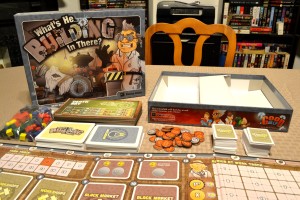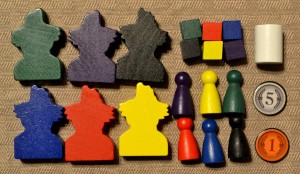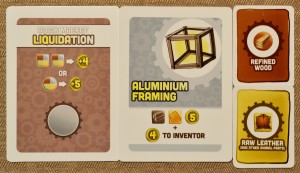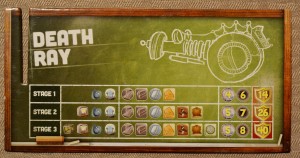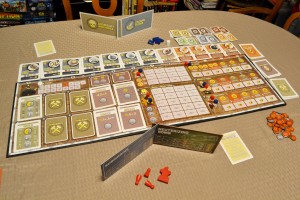Building doomsday machines seem to be the theme as of late, but seriously, when does being a mad inventor ever get tiring? “What’s He Building In There?” is a worker placement game that tasks players with earning the most victory points. As you may have deduced, building your doomsday device will assist you in reaching that goal. Before we all start laughing manically, I’d like to thank Sean Scott Garrity from Baksha Games for providing me with a free review copy.
Components
Game Board – The game board is broken up into many sections, though they all serve to help organize the events as they occur in the game as well as track a player’s individual progress.
Doomsday Machine & Escape Plan Boards – Each player receives one of each, which fit together to form a privacy screen. These serve as hidden goals and agendas that players will be attempting to complete in order to score points.
Pawns & Cubes – There are four pawns (one evil doctor and three henchmen) and five cubes of each player color. Players will be using the former to perform actions on the board (via worker placement) and the latter to track their progress along game board tracks.
White Cylinders – These consist of one starting player marker and one round marker.
Small Resource Cards – Resource cards are the raw materials that players will need to construct other things.
Workshop Cards – Workshops are places where players can assign pawns to perform actions. They are placed on the board and refresh themselves, so the types of workshops you’ll have available will change from round to round. Workshops serve as good places to acquire resources.
Black Market Cards – Black market cards are places where players can assign pawns to perform actions. Like workshops, they refresh themselves every round. The black market serves as a good place to trade for resources or gold.
Invention Cards – Invention cards are necessary components in building a doomsday device. They also incorporate a “royalties” mechanic, in which players must pay the original inventor a fee should they wish to create one for themselves.
Direct Invention Cards – These invention cards allow players to modify their own actions in some way to benefit themselves, or possibly to mess with someone else.
Turn Summary Cards – Each player receives one, which serves to assist them in taking their turn.
Money Tokens – Players will be earning and spending these throughout the game.
Setup & Gameplay
The board is placed between all players and everyone gets pawns and cubes of a particular color. Each player picks out a random doomsday device and escape plan board, setting them up to form a privacy screen. The workshop, black market, and direct invention cards are shuffled into separate decks, whereas the resource and invention cards are separated into their appropriate stacks. I’ll hold off on going into specifics, but the board (and manual) for the most part tells you where the cards need to go. The money tokens are placed off to the side to form a bank. The first player token is given to the person who last did something evil. The other players receive gold as compensation.
The game is played over fifteen rounds. The following phases are observed during a round:
1. Move Round Marker – The round marker is moved up to the next number on the game board.
2. Place Doctors/Henchmen – The starting player places either a doctor or henchmen on the board. Players continue in clockwise order until all doctors and henchmen are placed, being careful to observe any placement restrictions. I won’t go over all of them, but suffice it to say that some cards are only for doctors/henchmen and that pawns can’t share the same space.
3. Resolve Doctors/Henchmen – In the order according to the blue circles on the board, players resolve their actions. Players receive their pawns back as the actions are performed.
4. Invent – Beginning with the starting player going clockwise, players may create a maximum of one invention.
5. Pay Rent – Starting with round five, players must pay one gold each turn until the end of the game. Certain game conditions exempt players from this.
6. Replace Black Market, Workshop, and Direct Invention Cards – The black market and workshop cards on the board are refreshed with new cards. Direct invention cards are restocked only if players invented them during the round.
After fifteen rounds, all players check to see if they have completed AT LEAST the first level of their doomsday device and the first level of their escape plan. Those who didn’t automatically lose. Those who weren’t eliminated add up their victory points from their doomsday device, escape plan, inventions, and the various tracks on the game board. Whoever has the most victory points is the winner!
The above is simply an overview of the game, but should give you an idea of how it is played. For more information, please check out the manual, here:
http://bakshagames.net/WHBITWrittenRules.html
The Review
The components were of good quality, though the board is very large and has a tendency to not stay flat. It’s honestly not that big of a deal, but you will need a large table to accommodate the length of the board (which is similar to that of “Agricola” when you factor in the cards surrounding it). The manual is pretty in-depth, so expect to spend an hour or two reviewing the rules before sitting down to actually play. The core mechanics might be easy (place a worker, resolve, etc.), but there are a lot of different cards and effects to understand. I would have liked some extra baggies to have been included for the smaller resource cards and tokens…the game only came with one to accommodate the wooden pieces.
In terms of whether or not there’s any strategy to this game, I can answer that with a resounding “yes”. I found that I had a ton of options available to me, though turn order weighed heavily on just what those options were. Workshops can produce a multitude of things, but the first person to assign a pawn on one gets to choose what it’ll produce for that round. That, coupled with the fact that most cards have limited slots, made me seriously reconsider a lot of my initial strategies. I purposely avoided going into specifics during the gameplay explanation above, mainly due to how many different things the cards and spaces on the board did.
The way victory points are earned provides another huge boost to the replayability factor, mostly due to how random games are from one to the next. You never know what combinations of doomsday devices and escape plans players will end up having, making every game play out a bit differently. One direct invention card might mean nothing to you one game, but be extremely appealing the next based off of your new circumstances. The many options players have serve to balance things out rather well. If resources for your inventions are hard to come by for example, you might opt to focus your efforts on the exotic pets, security, and social tracks for the victory points that can be earned there.
I found the royalty mechanic of the invention cards to be a really neat idea. The original inventor will have to spend more resources to invent the component, but they’ll get royalties every time a player wants to build one too. It reminds me of the way buildings worked in “Lords of Waterdeep”, another game I thoroughly enjoyed in part due to this mechanic. An early invention might net you a lot of gold during the game, to which visits to the black market might be in order to acquire hard to come by resources. Royalties would also serve to help offset the rent you’ll need to pay after round four. Of course, these thoughts are just ripples in the pond compared to the plethora of strategies and options available to players at any one time.
In terms of complexity, I found this game to be a little tougher than “Lords of Waterdeep”. The hardest part was keeping track of all of the different inventions and resources I needed, and the fact that you only have fifteen rounds makes things all the more chaotic. Newcomers to the game (especially to the genre) might be overwhelmed at first, so give yourself an extra hour of playtime on your first few games to get accustomed to everything. Parents playing this game with younger children (especially those with ADD or ADHD) will need to be a little patient since there’s a lot of things going on at once.
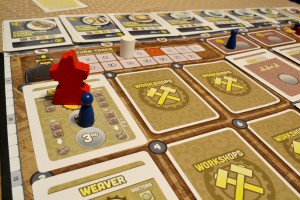
The workshop cards are straight-forward, though the inventions may require a little thought (no pun intended).
Overall, I found “What’s He Building In There?” to be an excellent game. It features some intense strategic play and has a ton of depth. Players will certainly be taking their time thinking about their every move, lest they want to fall behind and fail to complete the minimum necessary to score. It’s not an ideal game to introduce others to the genre (I’d recommend “Cargo Noir” for that), but it holds up among the best of them. Easily recommendable and loads of fun, this game has it all.
Final Verdict: 8/10
—
You can learn more about the game by visiting the following websites:
http://bakshagames.net/WhatsHeBuilding.html
http://www.kickstarter.com/projects/1817423053/whats-he-building-in-there-0
http://boardgamegeek.com/boardgame/137651/whats-he-building-in-there

